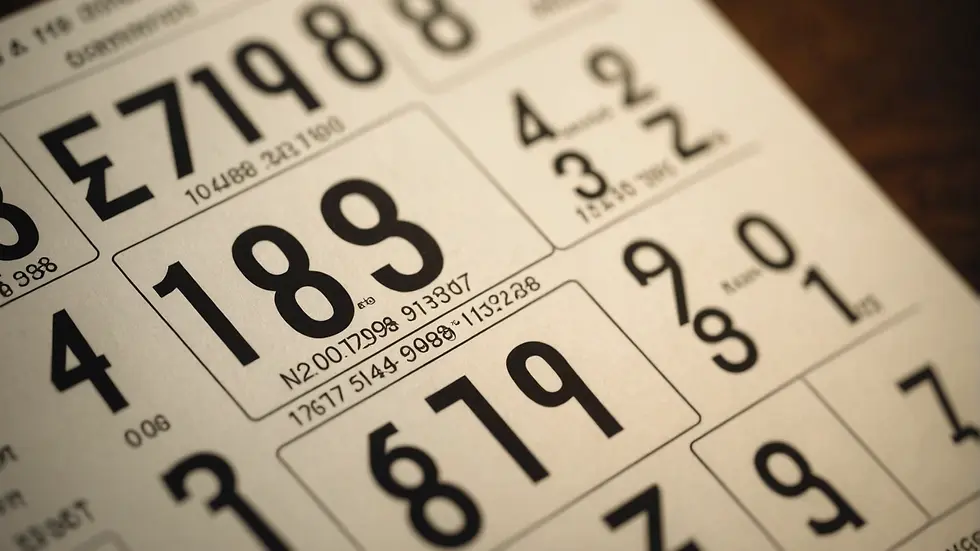The Enigmatic Elegance of Prime Numbers: Delving into the Intricacies of Mathematics
- dillscirque0i
- Nov 17, 2024
- 4 min read
Prime numbers are not just isolated digits; they are essential threads in the rich fabric of mathematics. These unique numbers have fascinated mathematicians and curious minds for centuries, offering a glimpse into the deeper structures that govern numerical relationships. This post will showcase the beauty of prime numbers, dive into their distinct properties, and highlight their intriguing patterns. Moreover, we will explore their real-world applications and present some fun puzzles to engage your mind.
What Are Prime Numbers?
Prime numbers are natural numbers greater than one that can only be divided evenly by 1 and themselves. This means that dividing a prime number by any other number won’t result in a whole number—except when dividing by one or the prime itself.
The first few prime numbers are 2, 3, 5, 7, 11, 13, and 17. Notably, 2 is the only even prime number; every other even number can be divided by 2. This fact makes it special among primes.
Primes serve as the building blocks for all natural numbers. In fact, every whole number greater than one is either a prime or can be factored into primes. For example, the number 30 can be expressed as 2 × 3 × 5, all of which are prime.
Unique Characteristics of Prime Numbers
The world of prime numbers is full of mystery. Though defined simply, their distribution grows sparser as the numbers get larger. This random nature often intrigues and frustrates mathematicians.
Density: According to the prime number theorem, the density of primes decreases as numbers increase. However, there are infinitely many prime numbers—a fact proven by the ancient Greek mathematician Euclid. To put this into perspective, there are 78 prime numbers less than 500.
Twin Primes: Twin primes are pairs of primes that differ by two. For instance, 11 and 13, and 17 and 19 are such pairs. The Twin Prime Conjecture proposes that there are infinitely many twin primes, but this intriguing hypothesis has not yet been proven.
Goldbach’s Conjecture: This famous unsolved problem suggests that every even integer greater than two can be expressed as the sum of two primes. For example, the even number 28 can be expressed as 11 + 17, both of which are primes. This is just one illustration of the mysteries surrounding prime numbers.

Patterns in Prime Numbers
Even though prime numbers may seem random, mathematicians have discovered several intriguing patterns:
Arithmetic Progressions: Some primes appear in linear sequences. For example, the series 7, 11, 13, and 17 showcases primes that follow specific intervals. Similarly, the progression of numbers like 5, 11, 17, and 23 also reveals a pattern based on characteristics of primes.
Prime Gaps: Prime gaps refer to the spaces between consecutive primes. For instance, between 11 and 13, there's a gap of 2, while between 17 and 19, the gap is also 2. Analyzing these gaps can yield insights that enhance our understanding of number theory.
Sieve of Eratosthenes: This ancient algorithm is an effective method for identifying all primes below a specified number. By marking the multiples of each prime starting from 2, the sieve elegantly demonstrates the spread of primes among integers.
Applications of Prime Numbers in Modern Society
Prime numbers are more than just a theoretical concept; they play crucial roles across various fields:
Cryptography: One of the most significant uses of prime numbers is in cryptographic systems, especially in public key encryption like RSA. This method relies on the difficulty of factoring large products of primes back into their original factors. For instance, while the product of the primes 61 and 53 equals 3,233, finding the original primes from this larger product is exceptionally challenging.
Random Number Generation: Prime numbers assist in creating sequences that exhibit true randomness. This property is vital for applications ranging from gaming to secure online transactions. For example, many secure websites use random number generators based on prime numbers to ensure data security.
Mathematical Research: Prime numbers continue to serve as a vibrant frontier for mathematical inquiry. Researchers use primes to explore new theories, test conjectures, and drive advancements in number theory. This field is alive with ongoing studies, including efforts to prove the Twin Prime Conjecture and Goldbach’s Conjecture.

Engaging with Prime Number Puzzles
Now that we've explored the wonder of prime numbers, let’s challenge your mathematical skills with some puzzles.
Challenge 1: Identify the Next Prime
Given the sequence of prime numbers: 7, 11, 13, 17... can you find the next prime number?
Answer: The next prime number in the sequence is 19.
Challenge 2: Goldbach’s Conjecture
Choose an even number between 4 and 30. Can you express it as the sum of two prime numbers?
Example: The number 26 can be expressed as 13 + 13, demonstrating Goldbach's hypothesis with prime numbers.
Challenge 3: Twin Primes
List all the twin primes between 1 and 50.
Answer: The twin primes in this range are (3, 5), (5, 7), (11, 13), (17, 19), (29, 31), and (41, 43).
Continuing the Passion for Primes
If you want to dive deeper into the subject of prime numbers, a wealth of resources is available:
Books: Titles like "The Music of the Primes" by Marcus du Sautoy provide fascinating narratives about the explores of prime numbers throughout history.
Online Communities: Forums like Art of Problem Solving, Math Stack Exchange, and blogs by mathematicians provide a plethora of discussions, problems, and insights into the world of primes.
Mathematical Software: Programs such as Mathematica or Python libraries allow enthusiasts to explore prime generation, patterns, and functions, offering hands-on experience in this captivating subject.
The Journey Ahead with Prime Numbers
The allure of prime numbers lies in their elegance and the endless mysteries they unveil for both professional mathematicians and casual enthusiasts. From their foundational role in number theory to their vital applications in cryptography and technology, primes captivate our imagination and challenge our understanding.
As you ponder the exploration of these fascinating numbers, consider how each prime represents a unique piece of the grand puzzle of mathematics. Whether you engage with mathematical puzzles, explore research opportunities, or simply appreciate their inherent beauty, the world of primes promises intrigue, unanswered questions, and a pathway to new discoveries in the realm of numbers.
What remarkable primes will you encounter on your mathematical journey?





Comments